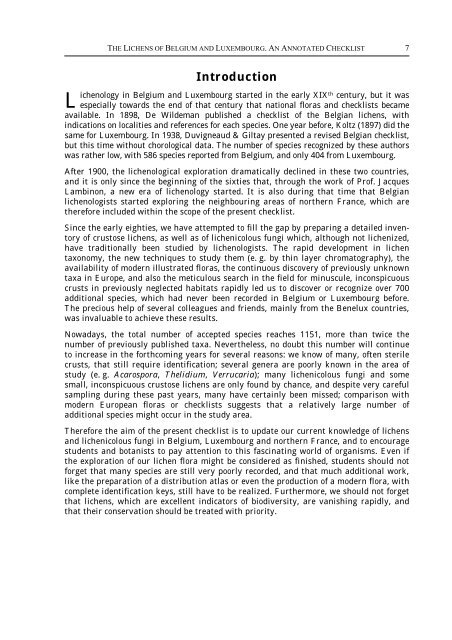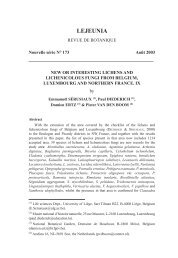The Lichens and Lichenicolous Fungi of Belgium and Luxembourg ...
The Lichens and Lichenicolous Fungi of Belgium and Luxembourg ...
The Lichens and Lichenicolous Fungi of Belgium and Luxembourg ...
You also want an ePaper? Increase the reach of your titles
YUMPU automatically turns print PDFs into web optimized ePapers that Google loves.
L<br />
THE LICHENS OF BELGIUM AND LUXEMBOURG. AN ANNOTATED CHECKLIST 7<br />
Introduction<br />
ichenology in <strong>Belgium</strong> <strong>and</strong> <strong>Luxembourg</strong> started in the early XIXth century, but it was<br />
especially towards the end <strong>of</strong> that century that national floras <strong>and</strong> checklists became<br />
available. In 1898, De Wildeman published a checklist <strong>of</strong> the Belgian lichens, with<br />
indications on localities <strong>and</strong> references for each species. One year before, Koltz (1897) did the<br />
same for <strong>Luxembourg</strong>. In 1938, Duvigneaud & Giltay presented a revised Belgian checklist,<br />
but this time without chorological data. <strong>The</strong> number <strong>of</strong> species recognized by these authors<br />
was rather low, with 586 species reported from <strong>Belgium</strong>, <strong>and</strong> only 404 from <strong>Luxembourg</strong>.<br />
After 1900, the lichenological exploration dramatically declined in these two countries,<br />
<strong>and</strong> it is only since the beginning <strong>of</strong> the sixties that, through the work <strong>of</strong> Pr<strong>of</strong>. Jacques<br />
Lambinon, a new era <strong>of</strong> lichenology started. It is also during that time that Belgian<br />
lichenologists started exploring the neighbouring areas <strong>of</strong> northern France, which are<br />
therefore included within the scope <strong>of</strong> the present checklist.<br />
Since the early eighties, we have attempted to fill the gap by preparing a detailed inventory<br />
<strong>of</strong> crustose lichens, as well as <strong>of</strong> lichenicolous fungi which, although not lichenized,<br />
have traditionally been studied by lichenologists. <strong>The</strong> rapid development in lichen<br />
taxonomy, the new techniques to study them (e. g. by thin layer chromatography), the<br />
availability <strong>of</strong> modern illustrated floras, the continuous discovery <strong>of</strong> previously unknown<br />
taxa in Europe, <strong>and</strong> also the meticulous search in the field for minuscule, inconspicuous<br />
crusts in previously neglected habitats rapidly led us to discover or recognize over 700<br />
additional species, which had never been recorded in <strong>Belgium</strong> or <strong>Luxembourg</strong> before.<br />
<strong>The</strong> precious help <strong>of</strong> several colleagues <strong>and</strong> friends, mainly from the Benelux countries,<br />
was invaluable to achieve these results.<br />
Nowadays, the total number <strong>of</strong> accepted species reaches 1151, more than twice the<br />
number <strong>of</strong> previously published taxa. Nevertheless, no doubt this number will continue<br />
to increase in the forthcoming years for several reasons: we know <strong>of</strong> many, <strong>of</strong>ten sterile<br />
crusts, that still require identification; several genera are poorly known in the area <strong>of</strong><br />
study (e. g. Acarospora, <strong>The</strong>lidium, Verrucaria); many lichenicolous fungi <strong>and</strong> some<br />
small, inconspicuous crustose lichens are only found by chance, <strong>and</strong> despite very careful<br />
sampling during these past years, many have certainly been missed; comparison with<br />
modern European floras or checklists suggests that a relatively large number <strong>of</strong><br />
additional species might occur in the study area.<br />
<strong>The</strong>refore the aim <strong>of</strong> the present checklist is to update our current knowledge <strong>of</strong> lichens<br />
<strong>and</strong> lichenicolous fungi in <strong>Belgium</strong>, <strong>Luxembourg</strong> <strong>and</strong> northern France, <strong>and</strong> to encourage<br />
students <strong>and</strong> botanists to pay attention to this fascinating world <strong>of</strong> organisms. Even if<br />
the exploration <strong>of</strong> our lichen flora might be considered as finished, students should not<br />
forget that many species are still very poorly recorded, <strong>and</strong> that much additional work,<br />
like the preparation <strong>of</strong> a distribution atlas or even the production <strong>of</strong> a modern flora, with<br />
complete identification keys, still have to be realized. Furthermore, we should not forget<br />
that lichens, which are excellent indicators <strong>of</strong> biodiversity, are vanishing rapidly, <strong>and</strong><br />
that their conservation should be treated with priority.





